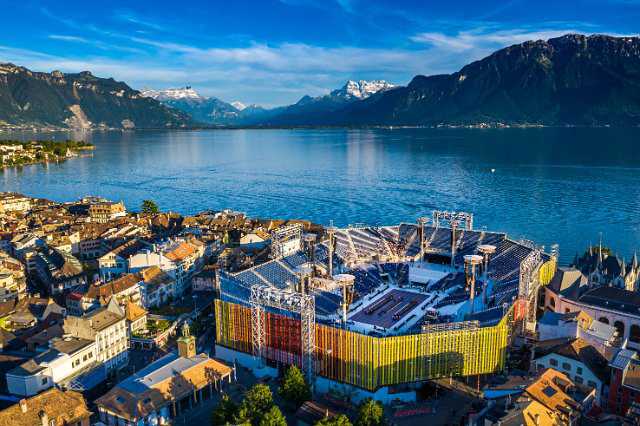Swiss spectacular enjoys a vintage year
- Details

Fête des Vignerons is a spectacular event which pays homage to the centuries-old traditions of the Brotherhood of Winegrowers, which covers the area from Pully to Vevey, in the Lavaux region of Switzerland. The centrepiece production takes place in a temporary arena, built on the banks of Lac Léman (Lake Geneva) and depicts a year in the life of the vineyard over 20 scenes.
Taking place from 18 July to 11 August, this year’s production comprised 23 shows, plus the coronation of the Vigneron-Tâcheron (wine-grower’s hand), traditionally regarded as the ‘keeper of the immemorial know-how’. It saw a quantum leap in the staging and production since it last took place in 1999, with today’s technology meaning the audio production could surpass the highest audience expectations.
The show’s design was for five stages - one in the centre, plus one on each side of the arena - so sound coverage was a complex issue. For the 1999 event, the audio system was mounted on a single tower in the middle, meaning all of the sound came from one point. This year’s technical director François Mottier wanted to make sure that the mistakes from last time weren’t repeated, with artistic director Daniele Finzi Pasca also very keen to address the issue of sound localisation.
Martin Reich, head of Swiss company Audioconsulting AG, was in charge of the production’s audio concept and system design, working closely with Gregor Baumann. Digital networking meant that Martin could give each of the five stages its own PA system that would cover the whole arena. This was achieved with eight main PA towers, plus surround speakers and fills around the outside and the centre of the arena and subwoofers under the seating.
“This was the best solution in a situation where any part of the PA could be 130m from the furthest audience point,” he says.
With a cast of 5500 actors, over 900 singers and musicians, plus a pre-recorded score by the Gstaad Festival Orchestra, Martin chose Yamaha digital mixing systems on twin Dante networks to handle the many audio channels, including 324 channels of Shure Axient digital wireless microphones.
“I realised that we would have to put everything in place once we were on site, because we wouldn’t necessarily have the information we needed up front. Dante would allow that, because it only needs a click of a mouse to change something quickly and reliably,” he says.
“The advantages of Yamaha Rivage PM series digital mixing systems were the sound quality, flexibility and the high channel count available on Dante - here we had 288 inputs on each system. Another was that there is a high degree of integration between the two. And with these advantages also came great reliability. With Yamaha we knew exactly what we would get.”
The networking was designed by Martin’s assistant and the event’s head of IP networks Gregor Baumann. He chose two parallel Dante networks - one for the live audio inputs to the RIVAGE PM systems and from them to the PA, the second for playback of backing tracks, live recording and virtual sound-checking - because it allowed the two Yamaha Nuage systems and the four 128-track recorders to be used as a recording pool, which could be assigned dynamically per production day.
The amount of wireless microphone channels meant that the entire bandwidth from 400 to 700mHz was needed, with the Axient receivers all connected via Yamaha Dante interface cards to Macintosh computers running Wavetools monitoring software. RF over fibre was also run to transmitters at various locations, some of which were over a kilometre away from the central monitoring location, allowing system checks via iPad.
(Jim Evans)
















